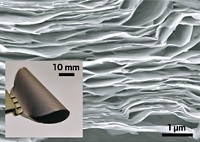Advertisement
Grab your lab coat. Let's get started
Welcome!
Welcome!
Create an account below to get 6 C&EN articles per month, receive newsletters and more - all free.
It seems this is your first time logging in online. Please enter the following information to continue.
As an ACS member you automatically get access to this site. All we need is few more details to create your reading experience.
Not you? Sign in with a different account.
Not you? Sign in with a different account.
ERROR 1
ERROR 1
ERROR 2
ERROR 2
ERROR 2
ERROR 2
ERROR 2
Password and Confirm password must match.
If you have an ACS member number, please enter it here so we can link this account to your membership. (optional)
ERROR 2
ACS values your privacy. By submitting your information, you are gaining access to C&EN and subscribing to our weekly newsletter. We use the information you provide to make your reading experience better, and we will never sell your data to third party members.
Materials
Carbon Crafted Into Membranes
Nanofiltration: New carbon-based materials could improve versatility of ultrathin membranes
by Stephen K. Ritter
January 30, 2012
| A version of this story appeared in
Volume 90, Issue 5

Water purification, seawater desalination, gas separations, and chemical filtrations could get a boost from two new carbon-based ultrathin membranes with unique properties: One selectively filters water, and the other selectively filters organic solvents, according to two reports in Science.
Rahul R. Nair, Andre K. Geim, and coworkers at the University of Manchester, in England, prepared graphene oxide laminates that are impermeable to liquids, vapors, and gases but allow water to pass through unimpeded (DOI: 10.1126/science.1211694). Separately, Santanu Karan, Izumi Ichinose, and coworkers at the National Institute for Materials Science, in Tsukuba, Japan, created amorphous carbon nanosheets that allow organic solvents through while rejecting organic dyes and gold nanoparticles (DOI: 10.1126/science.1212101).
“Carbon is among the most abundant elements in the universe, and some of its forms, such as charcoal and diamond, have been known for thousands of years,” observes chemical engineer Donald R. Paul of the University of Texas, Austin, who wrote a commentary accompanying the Science papers. But as the two reports show, he tells C&EN, scientists are still finding new ways to manipulate carbon to create materials with useful function.
For his work on graphenes, which are one-atom-thick sheets of carbon, Geim received the 2010 Nobel Prize in Physics. Now, by stacking graphene oxide, he and coworkers made 0.1- to 10-μm-thick membranes that stop everything except water, which passes through the thinnest membranes almost as if they weren’t there.
The researchers believe increasing humidity causes hydrophilic channels in the interlocked layers to expand, thereby allowing water molecules to make their way through empty spaces where the graphene isn’t oxidized. When humidity decreases, the channels close. The membranes could be used to dehumidify industrial gases or air-conditioning systems, as well as to filter contaminants from water or water from chemicals.
Meanwhile, Ichinose’s team made 10- to 40-nm-thick carbon nanosheets by plasma chemical vapor deposition of acetylene and other precursors. The stiff membranes contain a network of diamond-like sp3 carbon atoms and graphitelike sp2 carbon atoms perforated by 1-nm-diameter pores.
Organic solvents pass through the membranes at rates up to hundreds of liters per square meter per hour—about 1,000 times the rate of flow through commercial polyimide membranes, the researchers find. They note that the flux depends on solvent viscosity, not on solvent molecule size or polarity. Potential applications include chemical and biofuel production, environmental remediation, and food oil extraction.
These membrane materials “are clearly early-stage research and should stimulate further work,” Paul says. “It will be some time before we see actual applications. The real trick will be to make them on a large enough scale, and cheap enough, to be useful in packaged modules.”





Join the conversation
Contact the reporter
Submit a Letter to the Editor for publication
Engage with us on Twitter